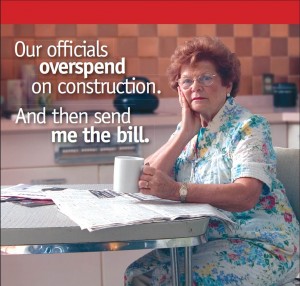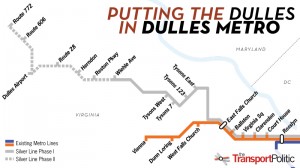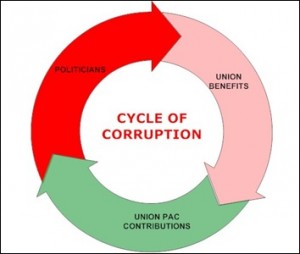Is Phase 2 of the Dulles Metrorail Silver Line Subject to a Government-Mandated Union Project Labor Agreement?
Will a recent deal to save the multi-billion dollar Phase 2 Dulles Metrorail Silver Line project in Northern Virginia force prime contractors to agree to an anti-competitive and costly project labor agreement (PLA) with labor unions in order to win construction contracts?
What level of protection will Virginia’s right-to-work law offer to the state’s nonunion construction workers?
Virginia taxpayers, public officials, businesses and construction workers deserve answers and public officials haven’t offered much clarity.
TheTruthAboutPLAs.com has monitored this project closely since the Metropolitan Washington Airports Authority (MWAA) passed an April 6, 2011, resolution requiring prime contractors to agree to a PLA similar to the agreement voluntarily entered into by the Phase 1 prime contractor, Dulles Transit Partners.
About the Silver Line
The Silver Line is a $6 billion project involving the construction of 23 miles of new Metro track.
Phase 1 of the Silver Line is under construction and runs from the Orange Line’s existing West Falls Church station through Tysons Corner to Reston. It is expected to open late next year, but contractors and MWAA officials have said it could be delayed and is as much as $150 million over budget.
Phase 2 of the Silver Line will run from Wiehle Avenue in Reston to just past Dulles International Airport in Loudoun County.
According to the original funding agreement, Phase 2 is financed by MWAA (4.1 percent), Loudoun County (4.8 percent), Fairfax County (16.1 percent) and the Commonwealth of Virginia ($275 million). Toll revenue generated from the MWAA-owned and operated Dulles Toll Road will fund the remainder of Phase 2.
MWAA says estimated revenue needed to fund Phase 2 construction will be similar to the toll schedule published in the July 2009 Wilbur Smith Associates traffic and toll revenue report commissioned by MWAA, which predicts Dulles Toll Road motorists will pay $16.75 each way in 2047 (see table 6-3 on p. 124). An updated study is expected to be completed in the next few months.
Broad Opposition to the Phase 2 PLA Mandate
Opposition to MWAA’s PLA mandate include the Loudoun County Board of Supervisors; Fairfax County Board of Supervisors; local, state and elected officials; The Washington Post editorial board; The Washington Examiner editorial board; Fairfax Chamber of Commerce; Dulles Regional Chamber of Commerce; Purcellville Business and Professional Association; a coalition of 13 of Northern Virginia’s leading business groups and associations; Women Construction Owners and Executives; and former Virginia Governor and U.S. Senator George Allen, who is running for the U.S. Senate in Virginia (see summary of entities opposing the Phase 2 PLA mandate here and here).
They know a PLA mandate will ensure discrimination against Virginia’s nonunion construction workforce (96 percent of Virginia’s construction workforce does not belong to a union) and reduce competition from qualified prime contractors opposed to PLA mandates.
An April 21 letter from ABC Virginia to MWAA explained how reduced competition and costly pro-union rules and fees within the proposed Phase 2 PLA circulated by MWAA earlier this year will increase Phase 2 bid costs by hundreds of millions of dollars and discriminate against Virginia’s construction workforce.

Unanticipated costs are problematic because financial stakeholders balked at Phase 2’s rising expenses, which ballooned to $3.825 billion – an increase of more than $1.8 billion (53 percent) compared to Phase 2’s initial $2.5 billion budget. This summer, U.S. Department of Transportation Secretary Ray LaHood was called in to negotiate an agreement between MWAA and state and local stakeholders to reduce costs and get the project back on track.
Is the Silver Line Back on Track?
On Nov.16, 2011, MWAA signed Resolution No. 11-33 approving a new Memorandum of Agreement (MOA) between the project’s financial stakeholders modifying the Phase 2 scope, financing structure and budget. It trims the Phase 2 costs from $3.825 billion to an estimated $2.8 billion, although these are only rough estimates at this stage in the project.
The MOA says the Commonwealth of Virginia agreed to contribute an additional $150 million, provided the funds are appropriated by the General Assembly and allocated by the Commonwealth Transportation Board in 2012.
The MOA places Loudoun County in charge of financing and building parking garages included in the original Phase 2 project plan. Likewise, Fairfax County must build two garages and a new Route 28 Metro station. These cost shifts from the original Phase 2 plan will be subsidized by federal Transportation Infrastructure Finance and Innovation Act (TIFIA) loans the localities can apply for in the coming months.
Loudoun County and Fairfax County recently agreed to the MOA, which gives them 90 days to opt out of the project after Phase 2 preliminary engineering, financing and cost estimates are released in early 2012.
In short, Phase 2 will face many financial hurdles in the coming months, although the project is in better shape now that costs have been trimmed and the local stakeholders have been given a larger role in planning the project.
The Facts About the Phase 2 PLA Mandate
Section 3.9 of the MOA refers to a “separate agreement on the matter of Project Labor Agreements for Phase 2” reached by MWAA and the Commonwealth of Virginia. While the PLA agreement (known as the PLA MOU) clarifies a PLA will not be mandated on Phase 2 subcontractors, it will not discriminate against nonunion contractors, and it will comply with Virginia’s Right to Work and contracting laws, Section 3 clearly states the prime contractor is subject to a PLA mandate:
“(3) no prime contractor working or seeking to work on Phase 2 shall be required, in order to secure or maintain a phase 2 prime contract, to become a party to any labor agreement other than the Phase 2 PLA; and” [emphasis added]
However, there remains great confusion about whether Phase 2 prime contractors are subject to a PLA mandate.
The confusion may be fueled in part because it is unclear if the Commonwealth of Virginia understands the PLA MOU. Thelma Drake, director of the Virginia Department of Rail and Public Transportation, signed the PLA MOU along with Commonwealth Secretary of Transportation Sean Connaughton. She said this about the Phase 2 PLA:
“The PLA is not mandatory,” Drake says. “You cannot require your prime to sign a PLA.”
For example, an article in Leesburg Today reported the PLA was optional and the controversy was resolved:
As part of the MOA, the state government also will be contributing more money, as has been pushed by many local leaders, up to $150 million, now [sic] controversy over MWAA’s plan to require a Project Labor Agreement has been resolved. The project plan, as originally created, had a requirement for labor workers to be used for the entirety of the second phase of the project. In Phase 1, the option is left to the individual contractor, something some leaders pushed for in the second phase.
In an agreement worked out directly between the state and the MWAA, the use of union contractors will be optional. “Neither will be discriminated against and will allow for all to participate in the bidding on the project,” York said, noting it was similar to the approach used in Phase 1.
The Loudoun Times reported the MOU “remove[d] the use of mandatory project labor agreements,” and “Virginia Gov. Bob McDonnell also agreed to give $150 million to help finance the rail extension as long as mandatory project labor agreements were eliminated.”
The truth is that it is a PLA mandate. A prime contractor must sign a union PLA in order to win Phase 2 construction contracts as a prime contractor.
A Nov. 16 Washington Times article, “Dulles Metrorail Phase 2 is right to work,” examines the impact of MWAA’s PLA mandate and PLA MOU with respect to Virginia’s right-to-work law:
Still, union-friendly labor agreements are a thorny issue in states such as Virginia that have right-to-work laws, under which workers cannot be required to join a union as a condition of employment.
“This agreement ensures that Virginia’s right-to-work laws will apply to every aspect of Phase 2,” said Secretary of Transportation Sean Connaughton. “It also will ensure that no one — contractors or subcontractors — will be forced to take on unions. It will also subject [Phase 2] to Virginia law. So we think it’s a major step forward from Phase 1.”
While Virginia believes the MOU offers prime contractors a measure of protection against forced unionism, Virginia has still given the green light for MWAA to mandate a PLA. This is problematic.
The public doesn’t know the final terms and conditions of the PLA now and may not know these terms until Virginia and local financial stakeholders have committed funding to the project. By then it may be too late to ensure Virginia taxpayers, workers and contractors maximize their investment in this project.
Right to Work and PLAs
The truth is that the PLA MOU and Virginia’s right-to-work law do not eliminate all of the anti-competitive and costly provisions of the draft Phase 2 PLA identified by ABC Virginia’s April 21 letter to MWAA. Virginia’s right-to-work law grants all employees the right to refrain from being a full union member and to pay either no or reduced union dues. Second, if the PLA requires all employees to be hired through an exclusive union hiring hall, the hiring hall may not discriminate between union and nonunion workers. However, typical union hiring hall rules give preferential treatment to out-of-work union members from all over the country ahead of qualified nonunion workers from Virginia seeking jobs on Phase 2. Officials don’t understand how this process works and allows unions to police themselves. It is rife with discrimination.
In addition, despite a right-to-work law, the PLA may still force contractors to pay into union slush funds used to harm merit shop contractors, force contractors and employees to follow archaic and inefficient union work rules, require contractors to only use union apprentices, and force unwanted union representation on employees for the life of the project.
The biggest concern most contractors have about PLA mandates is how these agreements typically require contractors to pay into underfunded multi-employer pension plans, exposing their businesses to significant financial liability (e.g., the Sheet Metal Workers National Pension fund is in critical status, according to the U.S. Department of Labor) and preventing workers from receiving retirement benefits rightfully earned. Employees will never benefit from fringe benefit contributions employers make to union pension and benefit plans unless the employee joins a union and meets vesting requirements. In order to ensure employees accumulate benefits they can eventually keep, contractors pay into their own existing benefit plans, artificially inflating their labor costs and making their bid uncompetitive against union firms free from double benefit costs. (This 2009 report by Dr. McGowan explains the anti-competitive and costly impact of pension contribution mandates in PLAs.)
Learn more about PLAs and right-to-work laws at TheTruthAboutPLAs.com blog post, Understanding PLAs in Right to Work States.
In short, Virginia’s right-to-work law does not make this government-mandated PLA any less offensive, nor will it increase competition.
Reduced Competition Will Increase Costs
Unfortunately, when faced with a government-mandated PLA, nonunion contractors and their existing workforces are presented with a false choice of agreeing to the union-favoring PLA in order to win a contract and perform work on Phase 2, or not pursuing work at all.
A reduction of two or three bidders because of MWAA’s PLA mandate could increase costs by hundreds of millions of dollars, depending on the final Phase 2 construction costs.
With strong evidence demonstrating that reduced competition increases bid costs, why would MWAA mandate an anti-competitive scheme that undermines the spirit of Virginia’s right-to-work law and has the potential to needlessly increase bid costs?
The answer, of course, is politics.
Politics and Corruption at MWAA
Unions overwhelmingly give campaign contributions to Democrats, which is a key reason why MWAA members appointed by Democrats or affiliated with the party supported MWAA’s PLA mandate. The public officials who appointed them know they will eventually benefit from union political contributions resulting from union job creation through this PLA. It is not surprising that MWAA board members with union ties orchestrated MWAA’s PLA mandate.
The Washington Examiner reported that Virginia GOP delegates Tim Hugo, Barbara Comstock and Thomas Greason sent a letter requesting that Virginia Attorney General Ken Cuccinelli (R) investigate the Phase 2 PLA mandate and possible ethics violation of MWAA board member Dennis Martire because he advocated for the Phase 2 PLA mandate that financially benefits his employer, the Laborers International Union of North America (LiUNA), (“Virginia lawmaker calls for probe of Dulles Rail labor pact,” 5/28).
Martire, appointed by Virginia Gov. Tim Kaine (D), is chairman of MWAA’s Planning and Construction Committee. He also is also a member of LiUNA Local 1058 and is currently employed as the vice president and Mid-Atlantic regional manager of LiUNA with an annual salary of $266,000, plus a generous benefit and pension package totaling $336,270, according to the most recent financial disclosure filings by LiUNA.
According to the Virginia Public Access Project, the Laborers Mid-Atlantic Regional Organizing Coalition has donated $419,050 to candidates and political action committees since 2007 — overwhelmingly to Democratic candidates. Creigh Deeds, unsuccessful candidate for governor, scooped up $250,000. Moving Virginia Forward, Tim Kaine’s PAC, garnered $55,000. LiUNA kicked in another $200,000 to the Democratic Party of Virginia in 2008. Martire was appointed by Gov. Kaine (D), in July 2009.
Martire’s employer, LiUNA, and its local affiliates (such as LiUNA Local 657, which bused in protestors to disrupt the April 18, 2011, press conference held by U.S. Rep. Frank Wolf and other local politicians to address concerns about Phase 2 of the project) will receive a significant financial windfall from the Phase 2 PLA that could easily exceed millions of dollars.
The PLA mandate will likely require the prime contractor to hire primarily union labor dispatched from LiUNA hiring halls (and union members performing labor in other trades from their respective union hiring halls) and force contractors to contribute into union slush funds and pension and benefit plans.
Martire’s MWAAA bio lists him as “a former Trustee to the National Heavy and Highway Alliance” (the same group that drafted the proposed Phase 2 PLA and the Phase 1 PLA voluntarily signed by DTP). Martire is also chairman of the Mid-Atlantic Laborers’ Employers Cooperation and Education Trust (LECET), which is a union fund contractors/employees are forced to pay into under the current LiUNA collective bargaining agreement that contractors would have to follow under the PLA.
The wage and benefit schedule contained in the current LiUNA collective bargaining agreement for LIUNA Local 657 and Local 11 (the LiUNA locals with jurisdiction over this project) highlight the benefit rates and plans contractors must pay into on behalf of their laborer employees if they are party to this agreement. Appendix A (page 20) lists the following hourly contributions contractors are required to pay to union funds by contractors (after collecting the hourly deductions from each laborer’s paycheck):
Pension: $1.99
Health and Welfare: $3.01
Training: $0.25
LECET: $0.10
CCC Industry Fund: $0.08
Total: $5.43 per hour
When Martire pushed for the PLA to apply to Phase 2 prime contractors and subcontractors earlier this year, this excel worksheet estimated the following financial windfall LiUNA and various LiUNA-affiliated funds will receive from a Phase 2 PLA mandate:
Pension: $21.544 million
Health and Welfare: $32.587 million
Training: $2.706 million
LECET: $1.082 million
CCC Industry Fund: $833,113.22
Dues: $8.081 million
Contractors Pay to CILM: $937,500 max.
This calculation doesn’t factor in benefits other unions besides LiUNA will receive as a result of the PLA mandate.
The amount of jobs created for union members and money flowing into union funds likely will be less because the recently executed PLA MOU states the PLA does not apply to subcontractors. However, MWAA will require the prime contractor to self-perform a significant amount of Phase 2 work, meaning a large portion of the Phase 2 project would be subject to a PLA. Spokespeople for DTP said they have self-performed 65 percent of Phase 1.
(Note: Merit shop subcontractors were exempted from signing the Phase 1 PLA agreement and MWAA has reported 60 percent of Phase 1 contracts have been awarded to nonunion shops that did not sign the Phase 2 PLA. This means the strong or poor performance of Phase 1 construction cannot be attributed to the voluntary PLA.)
In short, the total number of Phase 2 construction jobs created for union members and money paid to union funds is unknown until the project is completed, but they will certainly benefit from this PLA mandate.
While Martire’s conflict of interest is obvious, others have raised questions about a possible conflict of interest by MWAA board member Michael Curto, who was appointed by Maryland Gov. Martin O’Malley (D) in January 2011. MWAA board members recently elected Curto as their 2012 chair. Curto’s employer, Patton Boggs, has received between $1.25 million and $1.44 million per year since 2005 from Martire’s employer, LiUNA, according to recent union financial disclosure reports filed with the U.S. Department of Labor. Curto’s bio says he is a member of the firm’s Management Committee and head of the firm’s ERISA and Employee Benefits practice, representing corporate, nonprofit and government sponsors of pension and welfare benefit plans, including the type of union Taft-Hartley pension plans contractors would be forced to pay into under this PLA.
Curto introduced the PLA resolution, and Martire and Curto advocated for the resolution at the April, 6 2011, MWAA board meeting. Curto and Martire sit on the MWAA committees in charge of implementing the Phase 2 PLA, which is to be authorized by MWAA’s CEO and director. Both Curto and Martire voted for the resolution on April 6, 2011, when it passed 11-2. Both spoke to other MWAA board members and staff in support of this measure outside of MWAA meetings.
Martire authored this paper encouraging the use of government-mandated PLAs.
Despite all of these direct and indirect conflicts of interest, MWAA continues to defend Martire’s advocacy of a government-mandated PLA and denies he violated MWAA’s code of ethical responsibilities.
As the evidence demonstrates, at the very least, Martire should have excused himself from engaging in this decision, as this self-dealing undermines the public trust given to MWAA. MWAA should reveal to the public documents exonerating Martire and Curto from any wrongdoing.
Recent efforts to reform the MWAA board and an ongoing U.S. Department of Transportation Office of Inspector General audit of MWAA may prevent future ethical conflicts, but the damage is already done.
Taxpayers Benefit From Free and Open Competition
Taxpayers win with open competition free from anti-competitive and costly PLA mandates. Just look at taxpayer-funded projects free from government-mandated PLAs like the Wilson Bridge, the post- 9/11 renovations to the Pentagon, the Air Force memorial and many other high-profile projects in Virginia and the Washington, D.C. metro area.
The Commonwealth of Virginia, Loudoun County and Fairfax County would benefit from knowing the final terms and conditions of the Phase 2 PLA and its impact on competition and cost before agreeing to fund this project. Phase 2 of the Silver Line already has the potential to be Virginia’s Big Dig. Why not take the appropriate measures to protect taxpayers, create jobs for Virginians, increase competition, reduce costs and eradicate corruption at MWAA by ditching this dreadful PLA mandate policy?





















One Response to Is Phase 2 of the Dulles Metrorail Silver Line Subject to a Government-Mandated Union Project Labor Agreement?
Great article, but omits that on April 6, 2011, newspapers reported the MWAA board decided that the PLA with unions would be required as a CONDITION of bidding for Phase 2. In Phase 1 the PLA was voluntary AFTER bidding.
At a subsequent board meeting I attended, Chairman Snelling said he had an oral legal opinion, that was being put in writing, Phase 2 is subject to the Federal Davis Bacon Act and all new employees of the prime contractor would have to be union!
Phase 2 does not meet Federal and State guidelines for minimum population densities for economic operation. Dulles Rail will serve only 1.2% of the people in Fairfax, Loudoun and Prince William. Fairfax tolls are likely to be $10.70 one way in 2018, based on my realistic step-by-step calculations that have not been refuted by MWAA or any of over 100 involved people who have seen them.
This is a project driven by ideology, rather than careful assessments of the economics, costs to toll road users, taxes and Virginia’s right to work laws.